Step-by-step guide for damp specialist newcastle to identify moisture issues early
Step-by-step guide for damp specialist newcastle to identify moisture issues early
Blog Article
Recognizing the Relevance of Damp Proofing in Stopping Structural Damage
Wet proofing works as an important defense against moisture infiltration in buildings. This protective step can stop significant structural damages, yet many building owners continue to be unaware of its significance. Acknowledging the signs of dampness and comprehending the various options readily available can be essential. Ignoring damp proofing can lead to severe effects. What are the particular threats and solutions that homeowner should consider?
What Perspires Proofing and How Does It Function?
Moist proofing works as a crucial obstacle versus moisture intrusion in structures. mould removal newcastle. This process involves applying certain products and methods to avoid water from penetrating walls, floorings, and various other architectural aspects. Typically, damp proofing can be accomplished via the installment of damp proof membrane layers, coverings, or the usage of specialized sealants.These techniques function by producing a protective layer that prevents wetness activity, ensuring that the indoor environment continues to be healthy and balanced and completely dry. Moist proofing is specifically essential in areas vulnerable to high moisture or groundwater, as it assists preserve the stability of the structure over time.Moreover, efficient wet proofing contributes to power effectiveness by protecting against heat loss related to damp environments. By dealing with possible dampness problems prior to they intensify, damp proofing acts as a proactive step in safeguarding structures from the damaging impacts of water damages, ultimately prolonging their lifespan and preserving their value
Usual Indications of Moisture in a Building
Moisture concerns within a building can materialize with numerous noticeable indications that show the visibility of wetness. One noticeable indicator is the look of water discolorations on wall surfaces or ceilings, which commonly suggests dampness seepage. Additionally, peeling or gurgling paint can suggest that excess moisture is entraped underneath the surface, causing degeneration. Another common indicator is the existence of mold and mildew and mildew, which thrive in damp conditions and can typically be identified by their mildewy odor. A rise in moisture degrees can create condensation on windows and various other surfaces, highlighting moisture problems. Uneven or deformed flooring might indicate underlying wetness that jeopardizes architectural stability. Acknowledging these indications early can aid reduce possible damage and maintain a secure living atmosphere. Regular evaluations and prompt action are important in attending to dampness issues before they intensify.
The Risks of Disregarding Damp Proofing
Ignoring damp proofing can bring about substantial threats to a building's structural integrity, as wetness buildup may compromise foundations and wall surfaces. In addition, long term moisture creates a setting for mold development, positioning serious health and wellness risks to residents. Resolving these threats is necessary for making sure both safety and security and durability of the building.
Structural Stability Risks
When property owners neglect the importance of reliable wet proofing, they reveal their residential properties to significant architectural stability dangers. Long term wetness infiltration can result in the growth of mold and mildew, which damages fundamental elements and can endanger general stability. Additionally, excess dampness can wear down concrete and brickwork, causing fractures and architectural failures. Wood parts are specifically prone; they can rot and lose load-bearing capability, posing major risks to the building's framework. Furthermore, unattended damp problems may attract pests, such as termites, which even more aggravate architectural damage. Eventually, ignoring damp proofing measures can result in pricey repair services and potential safety dangers, emphasizing the necessary role of aggressive wet management in protecting the stability of houses.
Wellness Threat Concerns
How can a seemingly minor oversight bring about significant health risks? Neglecting wet proofing can develop an environment for mold growth, which presents significant wellness dangers. Mold and mildew spores can activate allergies, breathing issues, and other wellness issues, specifically in prone populaces such as kids, the elderly, and people with pre-existing conditions. Furthermore, persistent wetness can bring in bugs like insects and rats, which lug conditions that even more jeopardize health and wellness. The existence of wetness also adds to a decrease in indoor air high quality, aggravating asthma and other respiratory system conditions. The failure to address wet concerns not only threatens architectural stability yet additionally threatens the health of owners, highlighting the critical demand for effective moist proofing steps.
Various Types of Damp Proofing Solutions
Different variables can add to damp issues in structures, picking the appropriate moist proofing remedy is crucial for maintaining structural integrity. Several options are available, each tailored to particular conditions.One usual service is a damp-proof membrane layer (DPM), usually made of polyethylene or bitumen, which is mounted in wall surfaces and floors to stop wetness access. An additional choice is damp-proof training courses (DPC), which are layers of waterproof product positioned within wall surfaces to block climbing damp.Chemical damp proofing entails injecting waterproofing chemicals right into walls to develop an obstacle against dampness. Additionally, external treatments such as tanking, which includes using a get more info water resistant layer to the exterior of foundations, can be reliable in avoiding water penetration.Each option has its advantages and is picked based upon the building's specific concerns, environmental conditions, and lasting maintenance factors to consider, guaranteeing excellent security versus damp-related damages.

The Expense of Damp Damage vs. Prevention
Recognizing the economic effects of damp damage contrasted to avoidance highlights the significance of positive measures. The costs related to damp damages can be substantial, including repair work to structural elements, mold and mildew remediation, and prospective health-related costs. Home owners may face considerable economic pressure if considerable damage takes place, leading to boosted insurance policy premiums and lost residential property value.In comparison, purchasing moist proofing services is typically far extra affordable. First expenses for prevention approaches, such as improving or installing damp-proof membrane layers drainage systems, are frequently surpassed by the long-lasting cost savings from avoiding pricey repair services. Additionally, preventing damp problems can enhance a home's total worth and charm, making it a smart financial investment. When examining the expense of damp damage versus avoidance, it ends up being clear that taking proactive steps can secure economic rate of interests and keep the stability of the property with time.
Picking the Right Damp Proofing Approach for Your Home
Which damp proofing technique is most ideal for a particular residential property typically depends on numerous aspects, including the structure's age, existing wetness issues, and local ecological problems. For older frameworks, conventional methods such as bitumen membrane layers or cementitious finishes may be more reliable, as they can give a durable obstacle against climbing damp. On the other hand, more recent buildings might take advantage of modern-day solutions like infused damp-proof training courses, which are less intrusive and can be customized to particular dampness challenges.Additionally, buildings in areas with high water tables or heavy rains might call for even more innovative strategies, such as cavity wall water drainage systems or outside waterproofing. Property owners should likewise think about the specific materials utilized in their structure's building and construction, as some methods may not be compatible. Ultimately, an extensive assessment by a professional can lead residential or commercial property owners in selecting one of the most efficient moist proofing method tailored to their one-of-a-kind conditions.
Maintaining Your Damp Proofing System Gradually
Regular upkeep of a damp proofing system is necessary for guaranteeing its long-lasting efficiency and securing a residential or commercial property from moisture-related damages. Homeowner need to conduct routine evaluations to determine any kind of indicators of wear or compromise in the wet proofing layer. This consists of checking for fractures, peeling paint, or mold growth, which might suggest dampness intrusion.Additionally, it is suggested to clean rain gutters and downspouts routinely to avoid water build-up around the structure. Reapplying membranes or sealers might be needed if degeneration is observed.Engaging specialist solutions for periodic evaluations can better improve the resilience of the system. These specialists can provide understandings right into possible susceptabilities and advise prompt fixings.
Regularly Asked Questions
How Much Time Does Damp Proofing Treatment Last Prior To Needing Repair Services?
The long life of moist proofing therapy usually ranges from 10 to thirty years, relying on elements such as the method used, ecological problems, and upkeep practices. Normal inspections can aid establish when repairs may be required.
Is DIY Damp Proofing Effective Contrasted to Specialist Providers?
The efficiency of DIY wet proofing differs significantly. mould removal newcastle. While some people may attain adequate outcomes, expert services usually assure complete services, leveraging know-how and quality materials to stop future issues more accurately than a lot of do it yourself efforts
Can Damp Proofing Improve Indoor Air Top Quality?
The question of whether damp proofing can boost interior air quality emerges often. Reliable damp proofing lowers dampness levels, thereby reducing mold development and irritants, eventually contributing to a healthier interior setting for occupants.
Are There Specific Regulations for Damp Proofing in Various Areas?
Rules for moist proofing differ by area, usually affected by local building codes and ecological problems. Compliance assurances reliable moisture control, promoting and securing structures safety and security, which highlights the necessity for adherence to these specific regulations.

What Are the Long-Term Perks of Proper Damp Proofing?
The long-term advantages of proper wet proofing consist of boosted architectural integrity, reduced maintenance expenses, improved indoor air quality, and increased home worth. These benefits add to a much healthier living atmosphere and extended lifespan of buildings. Usually, damp proofing can be accomplished through the installment of moist proof membranes, coverings, or the usage of specialized sealants.These approaches work by developing a protective layer that prevents wetness activity, guaranteeing that the interior atmosphere stays healthy and balanced and dry. Damp proofing is particularly important in areas susceptible to high humidity or groundwater, as it assists preserve the honesty of the structure over time.Moreover, effective damp proofing adds to energy efficiency by avoiding warm loss associated with wet settings. Neglecting wet proofing can lead to substantial hazards to a building's architectural stability, as dampness build-up might damage walls and foundations (damp specialist newcastle). Different variables can add to damp issues in buildings, selecting the ideal moist proofing option is vital for maintaining structural honesty. Which damp proofing technique is most suitable for a certain building frequently depends on numerous aspects, consisting of the building's age, existing moisture concerns, and neighborhood ecological problems
Report this page